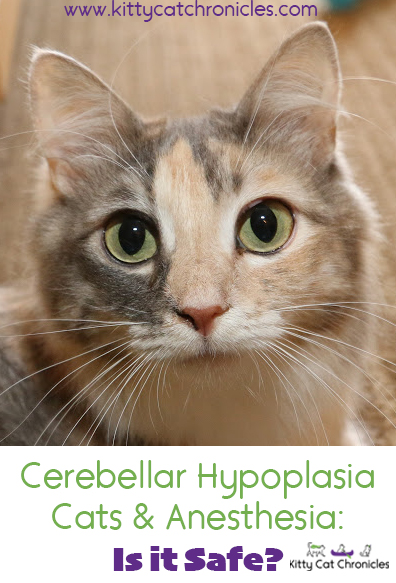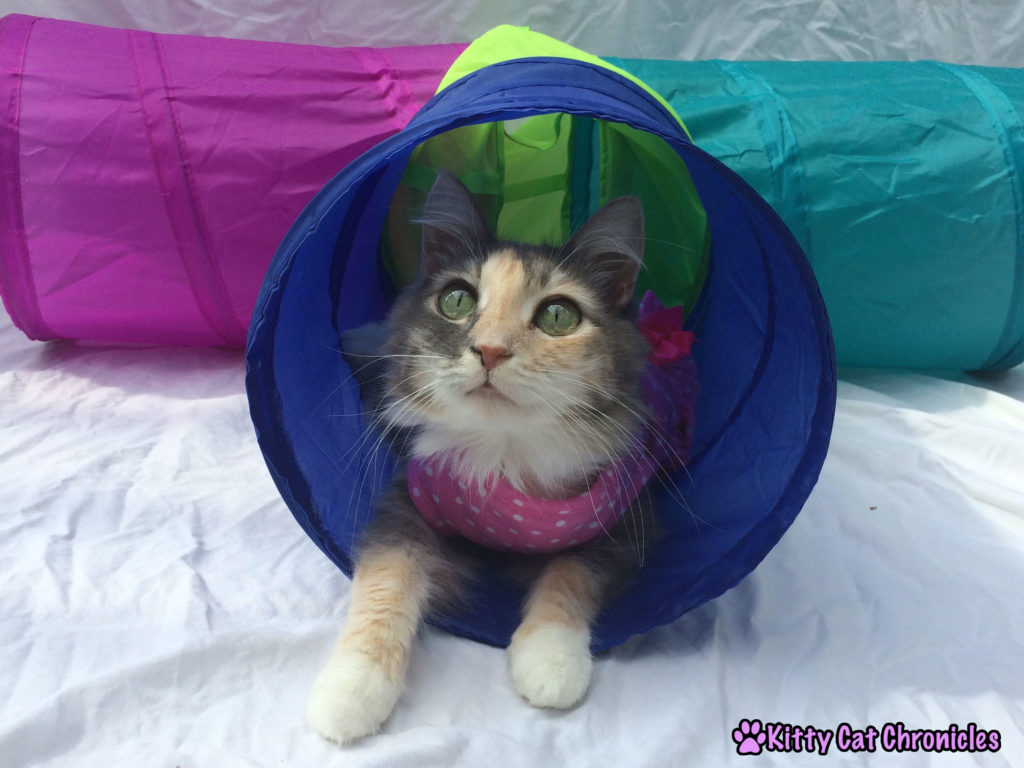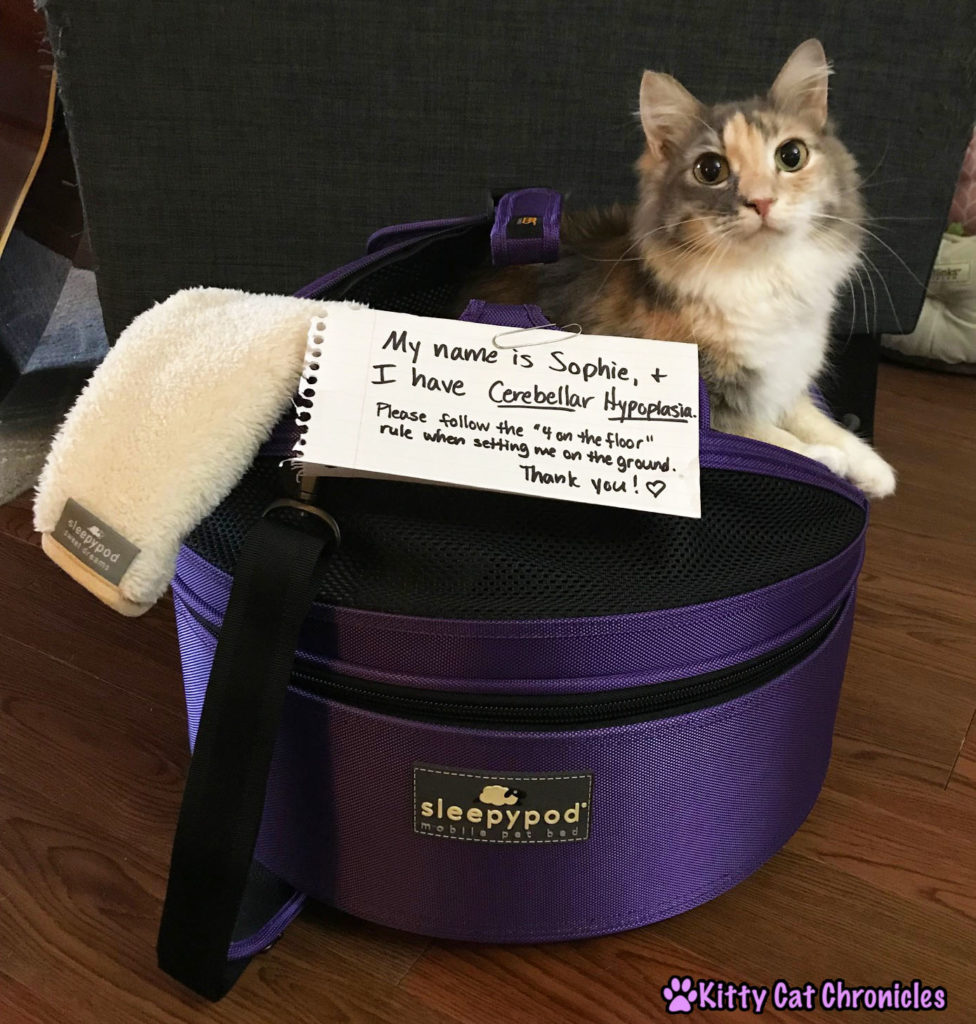The topic of anesthesia and cats with cerebellar hypoplasia is one that I’ve seen come up time and time again. Naturally, CH cat parents are usually worried about having their cat undergo surgery and anesthesia. After all, a kitty with cerebellar hypoplasia already has a brain that doesn’t function 100%. Can anesthesia make their condition worse? Can a CH cat handle anesthesia? Is it safe?

The short answer is YES – anesthesia IS safe for cats with cerebellar hypoplasia.
We just had our first experience with Sophie and anesthesia (she was already spayed when we adopted her), and I admit – I was worried. Even though I had seen the topic come up countless times in the Cerebellar Hypoplasia Cats & Kittens group on Facebook, I never paid too much attention to it because it had never been something that I was having to worry about. However, when our vet told us a couple of weeks ago that it was time for Sophie to have a dental cleaning, I immediately went into panic mode.
Dr. Caldwell (our vet) assured me that I had nothing to worry about. He explained that though Sophie’s cerebellum is not fully functioning, it is not a part of her brain that is in any way associated with her body’s processing of anesthesia drugs or medications. He explained that though there is always a very small risk associated with anesthesia, there is no more risk for Sophie than for any other cat. Phew.
That being said, there are still things that you will want to check into and do to make sure that your CH kitty has the best and safest anesthesia experience possible.
Make sure that your vet will complete the necessary health tests prior to anesthesia.
Like I mentioned before, there is always a small risk associated with anesthesia. It is estimated that approximately 1 in 100,000 animals will have some sort of reaction to an anesthetic agent. Thankfully, this risk does not increase for cats with cerebellar hypoplasia, but the risk does increase if your cat is not well. To lessen the odds of something going wrong while your cat is under anesthesia, you will want to make sure that you take your cat to a full-service vet that will complete the following checks and tests before putting your kitty under:
- a complete health history – identifying any risk factors or medical conditions (like CH), current medications and supplements, responses to previous anesthetic events
- a full physical examination to confirm that your cat is healthy
- blood work to check kidney and liver function
Confirm that your cat will be constantly monitored while under anesthesia.
Not all vets will provide constant monitoring of your cat’s vital signs while she is under anesthesia. You will want to make sure that the vet you take your CH cat to will be monitoring the following things throughout the entire anesthesia process:
- blood pressure
- temperature
- blood oxygen level
- exhaled carbon dioxide level
- heart activity (EKG)
You will also want to make sure that your cat will have an IV catheter so your vet can administer sedatives, anesthetics, sterile fluids, and pain medications. This should be done prior to anesthesia so that the veterinary team always has immediate access to your cat’s bloodstream.
Your cat should also be intubated once she has been heavily sedated or anesthetized. This means that your veterinarian will slip a tube through her mouth and down her trachea. The tube is then hooked up to an anesthetic gas/oxygen mixture. While intubated, your cat cannot accidentally inhale saliva or stomach contents if regurgitation occurs while she’s asleep. Also, if her breathing slows or stops, a technician or veterinarian can breathe for her using equipment attached to the anesthesia machine.

(Side note: If your vet is AAHA accredited, you can rest assured that they will be monitoring your cat during surgery and will be providing top-notch care throughout the entire process. For more information on what it means to be AAHA accredited, click here.)
Follow all pre-anesthesia directions given by your vet.
Your vet will probably tell you not to let your cat eat or drink anything for 8-12 hours before the procedure. Please follow these directions, as they are for your cat’s safety. If your cat has recently eaten, the risk of her regurgitating while under anesthesia increases.
Be sure to let your vet and everyone who will come into contact with your cat know that she has cerebellar hypoplasia.
It is of upmost importance that your vet and any other staff at the vet’s office are aware that your cat has cerebellar hypoplasia. Not just for the anesthesia, but also so that they are not surprised when your cat’s head bobbles or she falls over when walking. You don’t want to cause them undue alarm or concern.
They also need to know to follow the “4 on the floor” rule – meaning that after holding or handling your cat, all four of her feet need to be firmly on the floor before letting go.
You should ask make sure your vet knows not to trim you CHer’s nails. Cats with cerebellar hypoplasia rely on their nails for mobility and climbing, so most CH cat parents only clip their cat’s nails slightly, if even at all. It is standard practice at some vet clinics to trim an animal’s nails, so you’ll want to ask them not to do so.
Don’t assume that just because your vet knows your cat has CH that everyone else will know too. Communication sometimes falls through the cracks. To be thorough, you can make a label for your cat’s carrier like I did.

Know what to expect after the anesthesia.
Depending on the procedure and the drugs/medications that your cat is given during or after, she may or may not be extra wobbly for a little while afterwards. Our vet gave Sophie some pain medication after her dental procedure, which caused her to be out of it and a bit more wobbly and unstable than she usually is. He warned me before we took her home and explained that the effects of the medication would wear off in about 6-8 hours. As a result, he suggested that we keep her secluded to a small room so she wouldn’t accidentally hurt herself. Be sure to ask your vet what you should expect with your cat and for how long.
Thankfully, Sophie came out of her dental procedure just fine. There were no complications or issues with the anesthesia, and she is doing very well. While I worried all day long until I got the call from the vet’s office that she was awake and okay, I had some peace of mind knowing that she was in good hands.
I might have also texted Sophie’s foster mom to check with her about how Sophie did with her spay surgery all those years ago before we adopted her. She eased my fears and told me that Sophie had done just fine with the anesthesia.
If you have concerns about your CH cat and anesthesia, just be sure to have an open and honest conversation with your vet. Ask questions, express your concerns. Your vet should take the time to explain everything and calm your fears.
What an awesome info source! I’m so glad that Sophie came through the dental with no problems.
I too would have been a nervous wreck…until I could see with my own eyes that my kitty was just fine! Whew! That Sleepypod is gorgeous. May have to put some pennies aside every month, to buy one, two…three!
sophie….we R buzzed happee ya came thru de pro seedure total lee fine; grate post two day !!
☺☺♥♥
Excellent post, Emily with so much good info, even for those without a kitty wth cerebellar hypoplasia. Loved this photo of Sophie as well as all the photos on Facebook of the Adventure cats in the snow. Astrid sends Sampy oodles and oodles of kisses and all her love. XOCK, angel Lily Olivia, Mauricio, Misty May, Giulietta, angel Fiona, Astrid, Lisbeth, Calista Jo, Cooper Murphy and Sawyer
Very interesting information ! We’re glad that Sophie came through the dental so nicely. Purrs
a good lesson for every cat.
Excellent post. I am glad Sophie’s dental went well.
Anesthesia can be scary for any animal, but like you say, if you prepare beforehand, there shouldn’t be a problem. We’re glad Sophie came through the dental well.
Oh my, I know you really had to be worried about your dear sweetie but you made sure all was okay and gave us all something to thing about, CH or not. Howdy beautiful Sophie!
Great information. So glad Sophie’s dental procedure went well!
I am nervous even with ‘normal’ pets…glad Sophie came through her dental without any issues to worry about.
Excellent information! I’m glad that Sophie did well under anesthesia. The info you provided is great for any cat preparing for anesthesia as well!
I’m glad that Sophie had such great care and that the dental cleaning went so well! I think it is always better to be safe than sorry, so I think the reminder of “4 on the floor” is a great idea.
GREAT POST. Thank you for this. It doesn’t always hit us until we are affected and them BAM you go into panic mode. This is so reassuring for every CH cat owner – I pinned this before I finished reading!!
I have known two cats lots to anaesthesia allergies I think that’s different but scary too.
I’m glad Sophie’s dental went well. This was so interesting – I don’t have CB kitty so I never considered these issues. I like the 4 on the floor rule!
We had one scary experience with our cat Toonces. She was not being monitored and almost died during a dental procedure. The vet than tried to blame it on an undiagnosed heart issue. We rushed her to a cardiologist who did all kinds of tests and then concluded that she didn’t have a heart issue. He also said that anesthesia issue was a result of a vet error. We have obviously since switched vets and Toonces made a full recovery.
This is such valuable information. I think anyone with a CH kitty who was havin’ surgery would feel so much more at ease after readin’ this. This article will help peeps, for sure. Knowledge ALWAYS helps. purrs
I am so happy Sophie is doing well, this is an amazing post and I always learn from you although I don’t have cats. Will remember this if any of my friends ask about it in the future.
I remember seeing your note on the Sleepypod on social. You are such a great mom to Sophie and the crew. These are great precautionary tips to ensure cats with CH are safe as possible when having anesthesia. I’m glad that Sophie had no issues. She’s the cutest. Will pin and share this. Very helpful and informative post.
I never thought about anesthesia being a possible problem. This was a very informative article. I know I have to be extra careful with the girls, too, because of their flat faces. I’m dreading their first dental cleaning.
Great to know for all cat parents whose cats have CH. Glad that Sophie is doing good after the denral cleaning!
I would like to also mention to remind your vet to write down explicit instructions to NOT do a routine nail trim on a CH cat under anesthesia. I didn’t even think about it and they trimmed my babies nails so short when she was spayed that she couldn’t climb for 2 weeks. (I was furious!) It is very common for techs to trim nails while cats are knocked out. But, as many of us with CH cats know, we tend to keep their nails longer for gripping and climbing!
This is an excellent point! Thank you for mentioning it. I will add that in!
I had not heard of this condition before. You are right, sometimes vet techs do not know what they need to know about your cat’s condition so a sign is an excellent idea. Charts have a lot of information on them that sometimes gets glossed over. Thank you for sharing your insights.